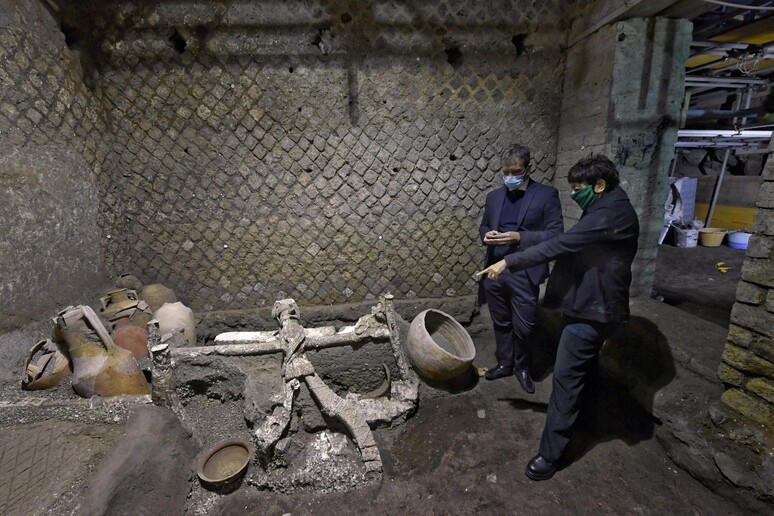(by Silvia Lambertucci)
Three beds of string and wood with evident signs of the matting
that covered them, the chamber pot still beside the beds, while
all around the space is occupied by work tools, the helm of the
cart that was just outside, the horses' tack, and large piles of
amphorae.
On the outskirts of Pompeii, the large suburban villa of
Civita Giuliana has yielded back the little room occupied by
stable slaves, perhaps a small family, still incredibly intact
with all their poor accoutrements.
A sort of snapshot of the end that ANSA has been able to see in
a sneak preview and which shines a light on the lives of the
lowest members of the affluent Roman colony buried by
Vesuvius in 79 AD.
"An exceptional find, because it is truly rare for history to
give back the details of these lives," says an enthusiastic
director of the archaeological park, Gabriel Zuchtriegel.
At Pompeii we are accustomed to the luxury of the frescoed
rooms, the marvels of the triclinia, the refined art of the
atriums and gardens.
Here, on the other hand, in the bare few metres of this dingy
space, a few paces from the stable that housed the superb
chestnut stallions of the master of the house, the raw reality
of things hits you with the harshness of its squalor, like a
blow to the stomach.
"We must thank the particular dynamics of the eruption, since
the room stayed intact until the arrival of the pyroclastic
flows, the portico held up, the lapilli stopped before the
threshold," says the director.
A living space that was miraculously preserved intact, and only
later profaned by the picks of the tomb raiders who came in
looking for other treasures.
The holes they left in the walls are the memory of the wounds
inflicted on the history of this imposing suburban estate before
prosecutors from Torre Annunziata stopped the desecration and
the excavations began, which are now aiming to bring the place
back into the light.
Even the beds of the slaves, reconstructed with startling
accuracy from the plaster casts, sadly bear the signs of that
ferocious invasion.
"But we are planning to fill in the gaps", says Zuchtriegel.
In the room, the three bunks are arranged in a horseshoe and are
of varying size, the smallest, no longer than a metre and 40
centimetres, destined for a child. The appearance is that of
essential, extremely simple pieces, "more bunks than beds," says
the director.
They were skillfully built, however, according to a modular
system that enabled them to lengthen or shorten the bed
depending on the height of the slsves who slept in them, akin to
an IKEA model for the ancient world.
No mattresses, just a piece of fabric laid over a network of
ropes which the plaster cast has restored to light with sharp
precision.
And nothing like the beds of the masters, which were always
fitted with a board and a soft mattress.
The walls are bare, no colour apart from a blotch of white paint
up high, below the small window, where a lamp was hung.
"It probably served to amplify the light produced by the fire,"
hazards Zuchtriegel.
Beneath one bed you can see a sort of basket, perhaps for the
few personal effects of the slaves, and also a small jug.
Who knows, perhaps it contained water for the night, or perhaps
something else, we'll find out in the laboratory, says
archaeologist Luana Toniolo, "when all the jugs, amphorae and
vases piled up alongside the beds will be analyzed in order to
find out what they contained".
The many work tools deserve separate mention: lying on the
child's bed there is the large helm of the cart, it was wooden
but the plaster cast has reproduced on one side of the fork a
large piece of stitching done with twine.
In the centre of the space, on the other hand, there is a large
box with metal corners which contained the horses' tack, wrapped
in a piece of cloth.
Zuchtriegel nods his head, it is a unique area, he repeats, "it
recounts situations of discomfort, of precariousness that we can
recognize".
That is one more reason to continue the digs and "to investigate
the villa in its entirety," says the director general of
museums, Massimo Osanna.
Belonging perhaps to a general, perhaps a high-ranking
magistrate, the Villa of the Harnessed Sorrel, as some people
have already dubbed this property, has been compared in size and
splendour to the Villa of Mysteries, with a residential space of
great luxury, sweeping terraces that looked out onto the bay,
and a major productive area.
The digs have already brought to light items of huge interest,
ranging from the stable with the magnificent harnessed horses to
the dazzling ceremonial chariot or carriage, the room decorated
with flowers that housed the little Mummy, perhaps one of the
daughters of the owners, and also the bodies of two fugitives
who died on the house's steps.
"The goal is to open it to the public," says Zuchtriegel.
The tomb raider, whose house is on top of the Roman villa, has
been convicted and the Park has already initiated the
expropriation of the land that will serve to continue the
excavation.
It will take time to complete, but it is worth the effort,
stresses the director, adding that "the new visitors' circuit
will also help boost the re-evaluation of the local area".
ALL RIGHTS RESERVED © Copyright ANSA











